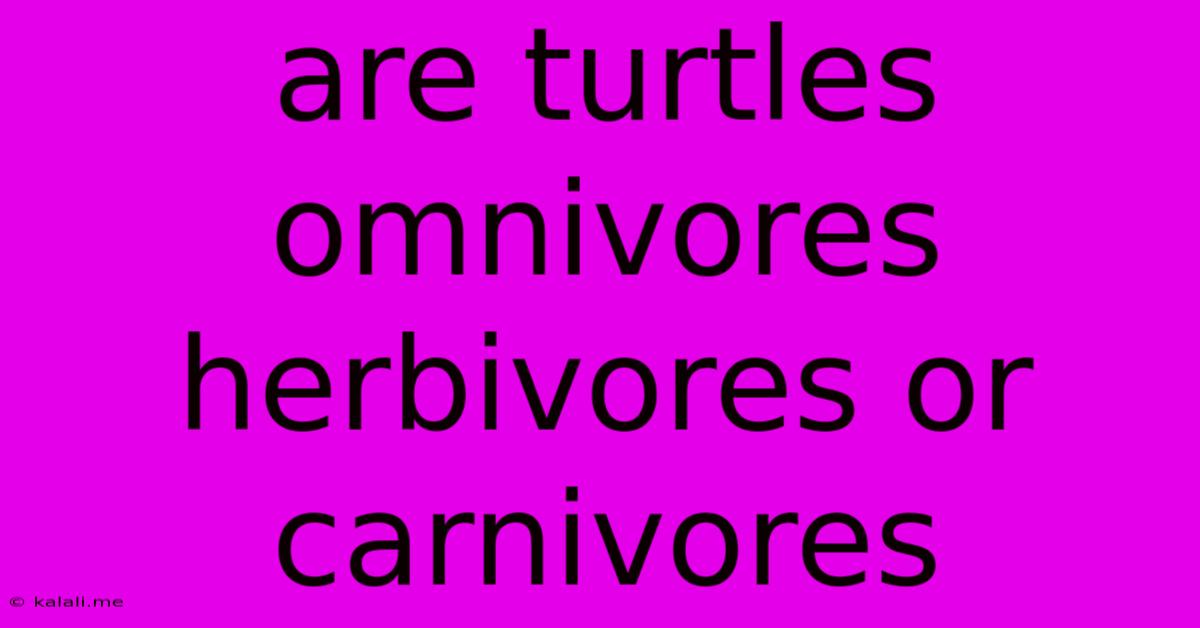Are Turtles Omnivores Herbivores Or Carnivores
Kalali
May 10, 2025 · 3 min read

Table of Contents
Are Turtles Omnivores, Herbivores, or Carnivores? A Deep Dive into Turtle Diets
Turtles, with their ancient lineage and diverse species, exhibit a fascinating range of dietary habits. While the general public might picture turtles munching on lettuce, the reality is far more nuanced. The answer to the question – are turtles omnivores, herbivores, or carnivores? – isn't a simple one. It depends entirely on the specific species of turtle. This article will explore the diverse diets of turtles, examining the different feeding strategies and the factors influencing their food choices.
Understanding Dietary Classifications
Before diving into the specifics of turtle diets, let's clarify the key terms:
- Herbivores: These animals primarily consume plants, including leaves, fruits, vegetables, and algae.
- Carnivores: These animals primarily eat meat, including fish, insects, crustaceans, and other animals.
- Omnivores: These animals consume both plants and animals.
Diverse Diets: A Spectrum of Turtle Feeding Habits
The truth is, the world of turtle diets is remarkably diverse. Some turtles are strictly herbivorous, while others are strictly carnivorous. Many, however, fall comfortably into the omnivorous category.
Herbivorous Turtles: Many species of turtles, particularly larger terrestrial species and some semi-aquatic varieties, are primarily herbivores. Their diets consist of a variety of plant matter, often including grasses, weeds, flowers, and fruits. Examples of predominantly herbivorous turtles include:
- Red-footed tortoises: These tortoises thrive on a diet rich in leafy greens, fruits, and vegetables.
- Sulcata tortoises: These large tortoises are known for their preference for grasses and hay.
- Many species of box turtles: These turtles have diets that heavily favor vegetation.
Carnivorous Turtles: Other turtle species are primarily carnivorous, relying on animal protein for their nutritional needs. These turtles are often adept hunters, preying on various aquatic organisms. Examples include:
- Snapping turtles: These fierce predators are known for their powerful jaws and carnivorous diet, consuming fish, amphibians, insects, and even small mammals.
- Many species of aquatic turtles: Many aquatic turtles are carnivores, consuming fish, crustaceans, insects, and other aquatic invertebrates.
- Map turtles: These semi-aquatic turtles are opportunistic carnivores, supplementing their diets with vegetation as well.
Omnivorous Turtles: A large number of turtle species are omnivorous, exhibiting flexible dietary habits that adapt to their environment and food availability. These turtles often consume a mixture of plants and animals. Examples include:
- Slider turtles: These popular pet turtles consume a wide range of foods including pellets, insects, vegetables and fruits.
- Painted turtles: These turtles are known for their opportunistic feeding habits, consuming both plants and animals.
- Many pond turtles: Their diets vary based on availability, including algae, insects, and small fish.
Factors Influencing Turtle Diets
Several factors influence a turtle's diet, including:
- Species: As discussed, the species of the turtle is the most significant determinant of its diet.
- Age: Young turtles often have different dietary needs than adults, sometimes exhibiting more carnivorous tendencies as juveniles.
- Habitat: The availability of food in a turtle's environment significantly impacts its diet. A turtle in a habitat rich in vegetation might be more herbivorous, while one in a water-rich environment with abundant aquatic life might be more carnivorous.
- Season: Seasonal changes in food availability can also influence a turtle's diet.
Conclusion: It's Complicated!
In conclusion, the question of whether turtles are omnivores, herbivores, or carnivores is not easily answered. Their dietary habits are surprisingly diverse, varying greatly depending on the specific species, age, habitat, and season. Understanding the specific dietary needs of different turtle species is crucial for their health and well-being, whether in the wild or in captivity. Proper research is key to providing appropriate care for these fascinating reptiles.
Latest Posts
Latest Posts
-
How Many Weight Watchers Points In 5 Ritz Crackers
Jul 02, 2025
-
1 Lb Of Pasta Is How Many Cups
Jul 02, 2025
-
What Does Lady Gaga Say In French In Bad Romance
Jul 02, 2025
-
How Many Square Yards In One Acre
Jul 02, 2025
-
What Is 2 3 Of 3 Quarts
Jul 02, 2025
Related Post
Thank you for visiting our website which covers about Are Turtles Omnivores Herbivores Or Carnivores . We hope the information provided has been useful to you. Feel free to contact us if you have any questions or need further assistance. See you next time and don't miss to bookmark.